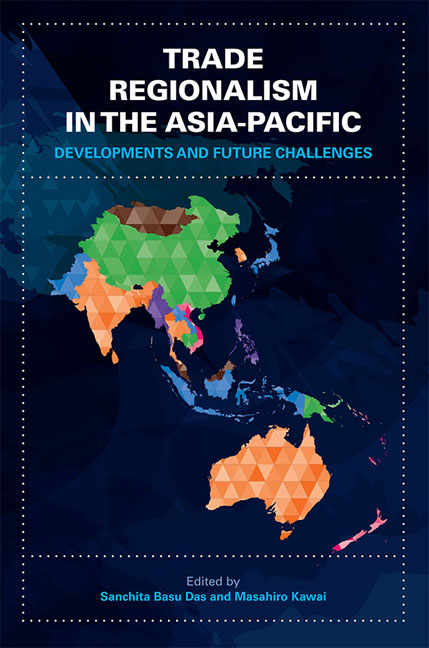Book contents
- Frontmatter
- Contents
- Foreword
- Acknowledgments
- List of Abbreviations
- The Contributors
- 1 Introductory Overview — Trade Regionalism in the Asia-Pacific: Developments and Future Challenges
- I The Trans-Pacific Partnership (TPP) Agreement
- 2 The Origins and Evolution of TPP Trade Negotiations
- 3 The Political Economy of Joining TPP: The Case of Malaysia
- 4 China and the TPP: Reflections and Responses
- 5 Japan and Entanglement of Regional Integration in the Asia-Pacific: Combining Cutting-Edge and Traditional Agendas
- II The Regional Comprehensive Economic Partnership (RCEP) Agreement
- III Regional Economic Integration: A Multi-stage Approach
- IV Old and Emerging Approaches to Asia-Pacific Regional Integration
- V Asia-Pacific Regional Integration: Towards Convergence?
- Index
5 - Japan and Entanglement of Regional Integration in the Asia-Pacific: Combining Cutting-Edge and Traditional Agendas
from I - The Trans-Pacific Partnership (TPP) Agreement
Published online by Cambridge University Press: 05 July 2016
- Frontmatter
- Contents
- Foreword
- Acknowledgments
- List of Abbreviations
- The Contributors
- 1 Introductory Overview — Trade Regionalism in the Asia-Pacific: Developments and Future Challenges
- I The Trans-Pacific Partnership (TPP) Agreement
- 2 The Origins and Evolution of TPP Trade Negotiations
- 3 The Political Economy of Joining TPP: The Case of Malaysia
- 4 China and the TPP: Reflections and Responses
- 5 Japan and Entanglement of Regional Integration in the Asia-Pacific: Combining Cutting-Edge and Traditional Agendas
- II The Regional Comprehensive Economic Partnership (RCEP) Agreement
- III Regional Economic Integration: A Multi-stage Approach
- IV Old and Emerging Approaches to Asia-Pacific Regional Integration
- V Asia-Pacific Regional Integration: Towards Convergence?
- Index
Summary
INTRODUCTION
As Figure 5.1 illustrates, only Japan thus far has participated in all of the regional economic integration schemes in East Asia and the Pacific: an FTA among China, Japan, and South Korea (hereafter CJK FTA), the Regional Comprehensive Economic Partnership (RCEP) comprising the ten countries of the Association of Southeast Asian Nations (ASEAN) and six of its FTA partners, and the U.S.-led Trans-Pacific Partnership (TPP). Japan has also been engaged in FTA negotiations with the EU, which has also progressed FTA negotiations with the United States, named the Transatlantic Trade and Investment Partnership (TTIP). If all of these agreements were concluded, the coverage ratio of Japan's overall trade by regional integration partners, including the EU, would increase from approximately 20 to 85 per cent, possibly making Japan one of the most advanced FTA countries in the region and presenting a “golden opportunity” for the Japanese economy.
This chapter aims to explore Japan's approach in the era of regional integration entanglement and attribute it to its strong interest in assisting Japanese corporations by making use of various benefits the TPP, RCEP, and CJK FTA would offer to Japan. Additionally, this chapter will identify what Japan hopes to achieve in each regional integration framework. Japan's differing interests in the three frameworks can be summarized as follows: TPP is likely to help the country in more advanced economic rule-making that includes cutting-edge agendas, such as the regulations of state-owned enterprises (SOEs), while strengthening the relations with its ally, the United States; RCEP is expected to increase market expansion, which encompasses big emerging economies, like China, India, and Indonesia; and finally, the CJK FTA framework is likely to promote investment protection in China and is also expected to function as a confidence-building mechanism at times when Japan's political relations with its two neighbours come under strain. Regional stability is a prime condition for sound business operations and investment, and this is especially true with China–Japan relations, as expressed by Sadayuki Sakakibara, Chairman of Nippon Keidanren, in his meeting with Wang Yang, China's Vice Premier in Beijing in September 2014. The chapter finally focuses on Japan's domestic politics and argues that the recent development of Japan's agricultural reforms under the Abe administration is expected to accelerate its fuller commitment towards regional integration negotiations.
- Type
- Chapter
- Information
- Trade Regionalism in the Asia-PacificDevelopments and Future Challenges, pp. 85 - 102Publisher: ISEAS–Yusof Ishak InstitutePrint publication year: 2016



